
Malakoff Diggins State Historic Park is a state park unit preserving the largest hydraulic mining site in California, United States. The mine was one of several hydraulic mining sites at the center of the 1882 landmark case Woodruff v. North Bloomfield Mining and Gravel Company. The mine pit and several Gold Rush-era buildings are listed on the National Register of Historic Places as the Malakoff Diggins-North Bloomfield Historic District. The "canyon" is 7,000 feet (2,100 m) long, as much as 3,000 feet (910 m) wide, and nearly 600 feet (180 m) deep in places. Visitors can see huge cliffs carved by mighty streams of water, results of the mining technique of washing away entire mountains of gravel to wash out the gold. The park is a 26-mile (42 km) drive north-east of Nevada City, California, in the Gold Rush country. The 3,143-acre (1,272 ha) park was established in 1965.
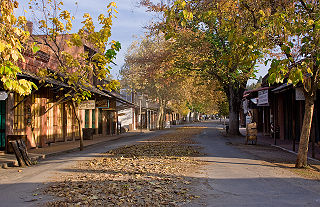
Columbia State Historic Park, also known as Columbia Historic District, is a state park unit and National Historic Landmark District preserving historic downtown Columbia, California, United States. It includes almost 30 buildings built during the California Gold Rush, most of which remain today. It was declared a National Historic Landmark in 1961.
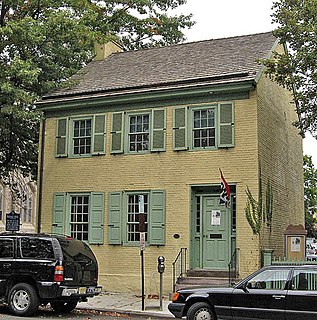
The James W. Marshall House, located at 60 Bridge Street in Lambertville, Hunterdon County, New Jersey, United States, was the boyhood home of James W. Marshall. Marshall's discovery of gold in the American River in California in January 1848 set the stage for the California Gold Rush. It is currently the headquarters of the Lambertville Historical Society.

This is a list of the National Register of Historic Places listings in Koochiching County, Minnesota. It is intended to be a complete list of the properties and districts on the National Register of Historic Places in Koochiching County, Minnesota, United States. The locations of National Register properties and districts for which the latitude and longitude coordinates are included below, may be seen in an online map.

The Ash Street School is a historic schoolhouse in Manchester, New Hampshire. It has been listed on the National Register of Historic Places since 1975. The school occupies the city block bounded by Ash, Bridge, Maple, and Pearl Streets.

Strang School District No. 36, or the Strang Public School, is a historic school located in Fillmore County, Nebraska, in the village of Strang. The school is one of the two sites listed on the National Register of Historic Places in the village of Strang. The school building is a small, two-story, brick public schoolhouse, which was built to replace the schoolhouse that was previously located on that site. The schoolhouse was built between 1929 and 1930, and replaced the previous schoolhouse, which burned down in 1928. The schoolhouse still retains all original building materials. The school served high school students from 1930 to 1951, and still functions as a school today, serving grades K–8. The NRHP listing also includes a flagpole located outside the schoolhouse, and five pieces of playground equipment.

The Honigsberger Store is a historic building located at 665 Main St. in Copperopolis, California. Businessman L. Honigsberger built the store in 1865, replacing the original store he built in 1861. The brick building was designed in the Neoclassical style. The store served Copperopolis during its first copper boom in the 1860s; however, an 1867 fire and declining copper production caused Copperopolis to lose most of its population and severely diminished the store's business. In 1905, the Honigsberger family sold the store to the Union Copper Mining Company, which became the Calaveras Copper Mining Company four years later. The company used the store as a warehouse during another copper boom in Copperopolis from 1909 to 1929. The store is one of only four extant buildings from Copperopolis' first copper boom in the 1860s.

Murphys Grammar School is a historic school building in Murphys, California. Built in 1860, the school was the first public school in Murphys. The school was designed in a vernacular Greek Revival style, which was popular at the time of its construction; its design includes a cornice held up by square pilasters, a pedimented gable, and a cupola over the entrance with its own cornice and square pilasters. The school operated continuously from its opening until it closed in 1973; at the time of its closing, it was the longest continuously running school west of the Mississippi River.

The Utica Mansion is a historic house located at 1103 Bush St. in Angels Camp, California. Built in 1882, the house was originally a two-story stone building designed in the Federal style. Robert Leeper, then owner of the Utica Mine, built the house next to the Utica Mill. Leeper sold the mine to C. D. Lane in 1884; he sold the house to Lane four years later. Lane and two other investors began to buy up mining claims in Angels Camp, and their enterprise soon became profitable. With his investment earnings, Lane began to expand the Utica Mansion. Lane added a two-story addition to the west and north sides of the house and a veranda on the other two sides. He also improved the interior furnishings by adding new wallpaper and fireplaces with English tiles, repainting the woodwork, adding gold moldings to hanging pictures, and installing Axminster carpets. Lane lived in the house until 1895, when he left to pursue an investment in Alaskan mining.

The Manhattan School is a historic schoolhouse located on Gold Street in Manhattan, Nevada. Built in 1913, the school was the third in Manhattan. The first school had opened in 1906, shortly after a gold rush in the community, and the second opened in 1908; however, by 1911 the local school district had 65 students and had outgrown its original buildings. Manhattan's voters unanimously passed a bond proposal for the new school the following year. Area contractor Angus McDonald built the school the year after. Upon its completion, a benefit party was held at the school to provide money for its furniture and a piano.

Ott's Assay Office is a historic assay office located at 130 Main Street in Nevada City, California. The building was constructed in 1851 as a drug store; James J. Ott opened his assay office in the back of the store in 1857. In 1859, Ott assayed a sample of silver ore discovered in the Washoe Country; this ore marked the discovery of the Comstock Lode, and the resulting silver rush eventually led to Nevada's statehood and several advancements in mining technology. The silver rush also gave Ott a reputation as a quality assayer; he ran his office until his death in 1907, and his son continued the business until 1955.

The Parents' and Children's Schoolhouse, located at 1505 Crane Court in Midland, Michigan, was constructed for use as a nursery school. It has since been adapted as a single-family home. It was listed on the National Register of Historic Places in 1996.
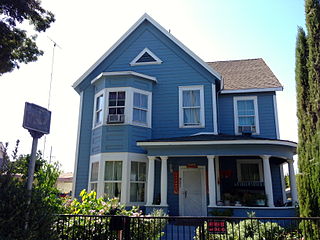
Moses Rodgers House is a private home in Stockton, California. Built in 1898, it was added to the National Register of Historic Places in 1978.
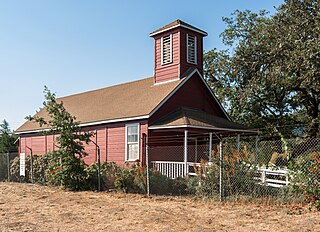
The Con Creek School, in Mendocino County, California near Boonville, California, was built in 1877. The school and another contributing building were listed on the National Register of Historic Places in 1979.

Fitch Hall, at the New Mexico Institute of Mining and Technology in Socorro, New Mexico, was built in 1937. It was listed on the National Register of Historic Places in 1989.

The Manchester Schoolhouse, at 19750 California State Route 1 in Manchester, California, was built in 1907, the year after the 1906 San Francisco earthquake. It was listed on the National Register of Historic Places in 1979.

The Semorile Building, at 975 1st St. in Napa, California, was built in 1888. It was listed on the National Register of Historic Places in 1974.

The South Branch Schoolhouse is a historic building at 2120 South Branch Road in Branchburg, Somerset County, New Jersey. It was built in 1873 with Late Victorian / Italianate style. The schoolhouse was added to the National Register of Historic Places on March 30, 2005 for its significance in architecture and education.

The Poncha Springs Schoolhouse, at 330 Burnett St. near Poncha Springs, Colorado in Chaffee County, Colorado, was built in Italianate style during 1881-83. It was listed on the National Register of Historic Places in 1990. It was then the Poncha Springs Town Hall and Museum.
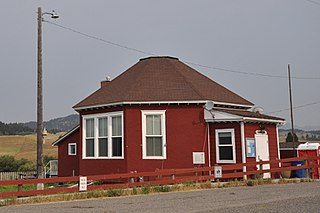
The Malmborg School in Bozeman, Montana is a one-room schoolhouse and the only octagonal school in Montana. Built in 1905, the schoolhouse is an example of the octagonal schools commonly found in the Mid-Atlantic and associated with mid-nineteenth-century reformer Orson Fowler's promotion of the “Octagon Mode of Building” in his book, A Home for All. The octagonal design of the school allowed for greater interior area and increased natural lighting, with windows present on three of the school's walls. The original school also featured an open front porch and an open bell tower, which were enclosed and removed in later renovations. The Malmborg School survived the consolidation of school districts and subsequent decline of one-room schoolhouses beginning in the 1920s and is still operational today as a K-8 school, with 12 students and 1 teacher in the 2019–2020 school year. The school was listed on the National Register of Historic Places on July 21, 1981. It was one of thirteen one-room schoolhouses listed together on the register on this date in Gallatin County, Montana. Three additional one-room schoolhouses in Gallatin County were listed on the register later.






















